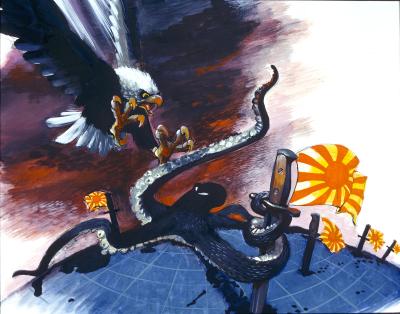Toon Talk: Walt Disney: On the Front Lines DVD
Page 2 of 4

Victory Through Air Power
(c) Disney
DISC ONE:
Most of the shorts in the set can be found on Disc One, divided into three sections, which can be viewed independently or with a ‘Play All’ function:
Propaganda and Entertainment Shorts:
These are basically the morale-boosters, as most of the films in general are of that era. Movie attendance grew during this period, as audiences rushed to such escapist fare as splashy musicals and gangster flicks, as well as, of course, the accompanying short subjects.
Viewed as the ‘Average Joe American’ in the Disney toon cast, Donald Duck was frequently employed during this time, as evident here with a series of shorts (beginning with Donald Gets Drafted) with Private Duck locking horns with the short-fused Sergeant Pete. Pluto and Goofy also make a few appearances (as well as a then unnamed Chip ‘n’ Dale, in their first appearance, in Private Pluto, which oddly goes unmentioned), but not Mickey Mouse himself, who was used very sparingly in this manner.
What I found most fascinating while watching the shorts in this section was the alarmingly casual use of racial stereotypes, especially of the Japanese in Commando Duck. But, as Maltin mentions in one of his many introductions, the most effective way to de-demonize the enemy was to make fun of them.
Educational Shorts:
Produced to help educate audiences on why we were fighting and how they themselves could help the war effort, these films succeeded in promoting the buying of war bonds (including four made for Canada re-using existing footage: Thrifty Pig, The Seven Wise Dwarfs, Donald’s Decision and the all-star All Together), encouraged Americans to pay their taxes on time (the delightful The New Spirit - where Donald has to pay all of $13 in income tax! - as well as its sequel, The Spirit of ’43), helped stem the fear of food shortages (Food Will Win the War and The Grain That Built a Hemisphere - you’ll learn more about corn in this one then you ever thought possible) and even showed, with the help of Minnie Mouse and Pluto, how something as simple as saving kitchen fats and meat drippings could help our men in uniform (Out of the Frying Pan and Into the Firing Line). All these films lay on the iconic imagery of patriotic propaganda, but there’s no doubt about their effectiveness or impact on the common viewer of the time.
Also included in this section are several shorts that were commissioned by the office of the Coordinator of Inter-American Affairs, and were shown mostly in Latin American countries to help viewers understand the importance of avoiding Malaria-spreading mosquitoes (in The Winged Scourge, starring the Seven Dwarfs) as well as, with a trio of shorts under the banner title of Health for the Americas, how to stay healthy through cleanliness and eating a balanced diet. While their ‘war’ themes are tenuous in the grand scheme of things, these productions are still helpful glimpses into the serious matters at hand during this period, and obviously encouraged Walt to continue with the more mainstream educational shorts of the following decades. Besides, where else can you see a Disney film teach you how to build an adequate latrine?
From the Vaults:
I’m sure most viewers who have been eagerly (if not so patiently) awaiting this set since its announcement (and subsequent postponement) will jump right to this section, and for good reason, for herein lies the Holy Grails: four animated shorts that were the artistic highpoints of the era, in terms of their power, importance and brilliance.
- Der Feuhrer’s Face
